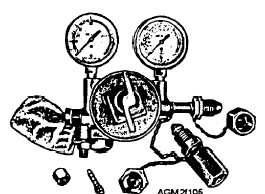Balloon Conditioning
As a result of exposure to relatively low
temperatures or extended storage, neoprene balloons
lose a portion of their elasticity through crystallization.
Balloons in this condition will burst prematurely.
Conditioning the balloons restores their elasticity and
helps ensure higher flights. Balloon conditioning
should be done to all balloons more than 1 year old or
that have been stored in cold temperatures. For Navy
and Marine Corps observations, balloons may be
conditioned by immersing the balloon in boiling or
nearly boiling water for 5 minutes.
Balloon Inflation
Proper balloon inflation procedures are not
published for the MRS system. The 100-gram and 300-
gram balloons must be inflated so that the ascension rate
keeps the MRS system active. Slower ascension rates
may be interpreted as a leaking balloon, and the system
will terminate the sounding. Faster ascension rates
prevent accurate data sampling and may also result in
automatic sounding termination by the receiver. The
ideal ascension rate for a balloon is between 900 feet
per minute and 1,000 feet per minute.
INFLATION GASES.—Helium is the safest
lighter-than-air gas for use in inflating meteorological
balloons. It is inert and will cause no fire, explosion, or
health problems. Hydrogen or natural gas can be used
in an emergency if helium is not available, but both
gases are explosively flammable and pose serious
safety hazards. Their use is not recommended. The
AN/TMQ-3 hydrogen generator set has been used at
some remote upper-air sites to produce hydrogen gas
locally.
Two types of helium may be used to inflate
balloons: oil-free and oil-pumped helium. Oil-free
helium is supplied in metal compressed-gas bottles that
are about 4.5-feet high; the bottles are painted gray, with
the top portion of the bottle and valve cover painted
yellow or brown. Since this gas is not hazardous to
health, the bottle connection is a standard screw thread.
Oil-pumped helium, however, contains more
contaminants than oil-free helium, and may cause
health problems ifbreathed. These cylinders are painted
gray with an orange band around the cylinder, and the
cylinder connection has a reverse-screw thread.
The standard pressure-reducing helium regulator
(fig. 1-5) is usually painted bright orange, and is used to
regulate the flow of gas into the balloon. The regulator
is attached to the oil-free helium bottles with an adaptor
(on the chain). The indicator dial nearest the cylinder
connection indicates total pressure in the helium
cylinder (normally 2,000 psi when full) on the outer
scale, and cubic feet of helium (220 cubic feet when
full) on the inner scale.
The second indicator dial shows the low-pressure
flow to the regulator outlet. The low-pressure flow is
adjusted by turning the T-handle on the valve body;
turning the T-handle clockwise shuts off the flow.
Before the regulator is removed from the cylinder, the
helium cylinder valve must be closed and the pressure
bled from the regulator. A low-pressure hose is not
supplied with the regulator.
Several suitable low-
pressure hoses are available through the supply system,
but you may use a clear plastic, 3/8-inch-diameter hose
that is lightweight and flexible. Use screw clamps to
connect the hose from the regulator nipple to the
inflation nozzle. Helium flow should be set during
inflation at about 15 psi on the low-pressure gauge.
Inflating balloons at higher settings will inflate the
balloon too rapidly and stress the neoprene, resulting in
premature balloon failure. Flow of gas into the balloon
is controlled by the on/off valve on the weighted balloon
nozzle.
INFLATING BALLOONS.—The
ideal
ascension rate for a 100-gram or 300-gram balloon is
900 to 1,000 feet per minute. This rate is achieved by
inflating the balloon to neutral buoyancy (the balloon
will neither rise nor sink on its own) while attached to an
inflation nozzle weighted from approximately 600 to
1,000 grams (1.3 to 2.2 pounds). Before release, the
weighted nozzle is removed and the 250-gram MRS
RS-80 series rawinsonde instrument is attached to the
balloon. A 100-gram balloon should have a free lift of
about 600 to 800 grams, and a 300-gram balloon should
have a free lift of between 800 to 1,000 grams.
Figure l-5.—Standard pressure-reducing helium regulator.
1-7


